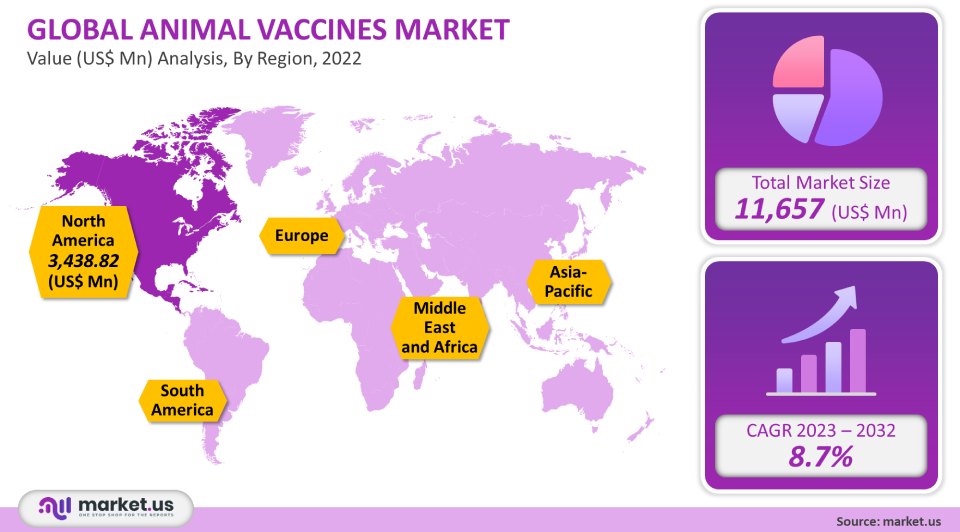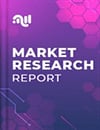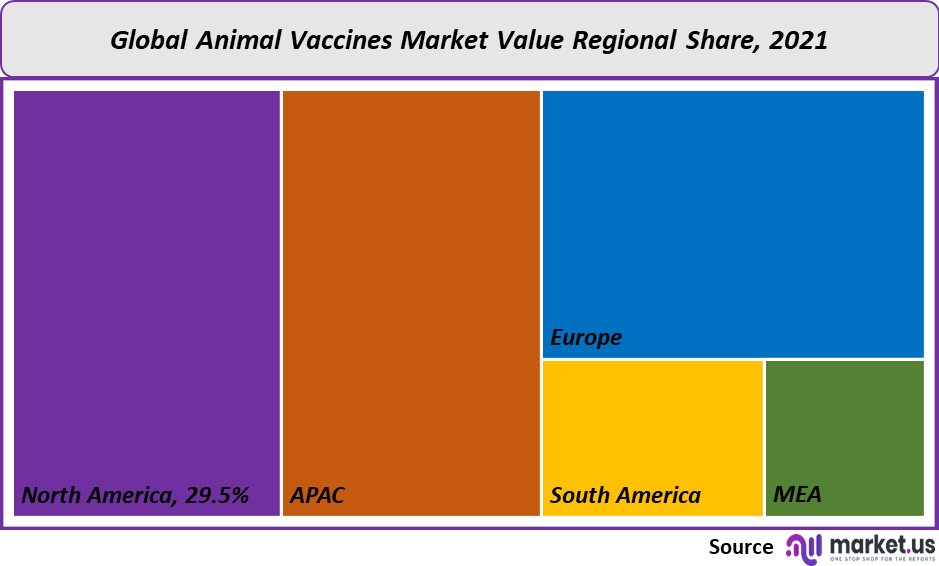Global Animal Vaccines Market By Product (Attenuated Live Vaccines, Inactivated Vaccines, Subunit Vaccines, DNA Vaccines, Recombinant Vaccines), By Animal Type (Livestock, Companion), By Route of Administration (Subcutaneous, Intramuscular, Intranasal), By Region and Companies - Industry Segment Outlook, Market Assessment, Competition Scenario, Trends and Forecast 2023-2032
- Published date: May 2023
- Report ID: 54840
- Number of Pages: 376
- Format:
- keyboard_arrow_up
Quick Navigation
Animal Vaccines Market Overview:
The global market for animal vaccines was valued at USD 11,657 million in 2021. This number is projected to increase at a compound annual growth rate (CAGR) of 8.7% from 2023-2032.
The rising incidences of cattle disease and the growing livestock population are key factors in the widespread acceptance of ruminants worldwide, especially cow vaccines. Animals provide a vital source of meat, protein, and milk as well as other commercial products like wool, leather, and food. The most widely used animal vaccines include rabies vaccines as well as equine influenza virus vaccines. These vaccines protect against the transmission of infectious agents and mimic the natural immunity that animals have.
Global Animal Vaccines Market Scope:
Product Analysis
The attenuated segment of live vaccines for animals dominated the market. In 2021, it accounted for a 37.6% revenue share. Live attenuation has been used for vaccination since the beginning of the veterinary profession. Additional applications are being developed using this method. There are also protein subunit vaccines that can be administered intramuscularly to swine. These products reduce the mortality rate of disease-affected porcine and increase their life expectancy. The recombinant vaccine segment is forecast to grow at a rapid pace over the forecast period. These vaccines are effective in reducing the risk of animals becoming ill after vaccination. Recombinant vaccines will also help in the prevention of multiple virus strains. These vaccines can be made without adjuvants to increase viability, stability, and avoidance of side effects. Many recombinant veterinary vaccines are available against canine distemper.

Animal Type Analysis
With a share of 72.6% or more in revenue, the livestock market dominated the market. This can be explained by factors such as a growing livestock population, supportive government initiatives, and the spread of disease among cattle and sheep. Avangard, Nobilis, and E. coli Inc by Merck & Co., Inc. are some of the vaccines for E. coli prevention. Zoetis states that E. coli rates vary in cattle. They can be found in feedlot cattle, cattle on grassland, cattle at harvest, cattle on irrigated land, and cattle on slaughter.
The forecast period is expected to see the highest growth rates in the companion section. Canine dysentery virus is transmitted by both house pets and ferrets. Post-infection treatment is not available. Morbillivirus causes distemper in dogs, cats, raccoons, and dogs. It can also be transmitted by air between healthy and infected animals. Canine distemper can cause severe damage to the respiratory, bladder, and gastrointestinal systems. It is imperative that dogs are immunized. The disease is more prevalent in puppies and dogs that have had bacterial infections of the gastrointestinal system.
Route of Administration Analysis
In 2021, the subcutaneous segment held a dominant position in the animal vaccines market. It had a revenue share exceeding 43.5%. Most animals’ subcutaneous injection points are located below the neck and shoulder blades. It is expected that the subcutaneous administration of drugs will increase market growth because they can be absorbed slowly. The subcutaneous route is easier and less painful for animals. It is also simpler to train veterinary technicians to administer subcutaneous injections. The most commonly used routes of administration in animals are subcutaneous and intramuscular. These factors help to promote market growth.
Intranasal vaccines are expected to show the fastest growth rate, 8.8%, during the forecast period. This is due to their increasing popularity. Most intranasal shots only contain one dose. The market is expected to grow due to the growing incidence of respiratory diseases in animals as well as rising research efforts by market players for better vaccines.
Key Market Segments:
By Product
- Attenuated Live Vaccines
- Inactivated Vaccines
- Subunit Vaccines
- DNA Vaccines
- Recombinant Vaccines
By Animal type
- Livestock
- Poultry
- Aqua
- Ruminants
- Swine
- Companion
- Canine
- Feline
- Others
By Route of Administration
- Subcutaneous
- Intramuscular
- Intranasal
Market Dynamics:
Increasing concern about food security and the increasing demand for vaccines for livestock are driving up the demand. The global increase in livestock production is due to the rising demand for the animal product. The demand for livestock products is also increasing due to a variety of factors like changing lifestyles, population growth, and food preferences. These factors are boosting the market. A shift in market dynamics has also been caused by the continuous introduction of technologically advanced vaccinations and the outbreaks of livestock diseases.
In 2020, there was moderate growth. The COVID-19 Pandemic has affected all industries, as well as animal vaccines. OIE confirmed that animals cannot spread the virus during the initial period of the pandemic. In a few countries, however, it has been confirmed that there is human-to–animal transmission. IDEXX Laboratories as well as other companies tested many dogs, cats, and horses for the disease. All tests were negative. The initial months of the pandemic saw speculations that the virus might spread through birds. This adversely affected the livestock industry. Numerous U.S. poultry processing plants and pig farms were shut down by the severe outbreak. India’s poultry sector has lost more than USD 1B due to worries and fears regarding the novel coronavirus.
In India, 9 states reported a bird influenza outbreak in December 2020. The result was a drop in prices for poultry products, which has severely affected the entire livestock industry. According to India’s Poultry Federation, India, the consumption of chicken has decreased to 50%. Prices have dropped 30% since December 2020. India is one of the few countries in Asia that have adopted vaccination policies. The Haryana State Government and Punjab are close to legalizing vaccines. This can have a positive impact on market growth.
In June 2021, the U.K. officially established the U.K. Animal Vaccine Manufacturing and Innovation Centre located in Surrey. This center will accelerate vaccine development for livestock and reduce the spread of viral diseases such as coronavirus. To fund the establishment of this center, the U.K. government and Bill & Melinda Gates Foundation will each contribute US$ 24.79 million. It will be possible to expand the animal vaccines sector through the adoption of market-leading research and the growing number of COVID-19 infected animals.
A rising number of zoonotic illnesses can have negative consequences for human life, which could increase the demand for animal vaccines. Emerging exotic animal diseases pose a significant threat to both animal and human health. This can also jeopardize food security. The chances of transmission between and within species are increased by the increasing population of both humans as well as environmental degradation and globalized travel and trade. The resultant diseases pose huge challenges both now and in the future. In most countries, increased demand for animal proteins has led to an increase in commercial food animal production. Public health is being threatened by emerging zoonotic infections in companion and livestock animal animals. Over the coming decades, emerging disease outbreaks will continue to plague the world. Animal vaccines can be a vital part of controlling emerging diseases.
Regional Analysis:
North America dominated the market in 2021 and accounted to be 29.5% of total revenue. This region is expected to continue to be dominant over the forecast period. This large share can be explained by the high prevalence and severity of zoonotic infections that cause large-scale livestock deaths. A large number of well-established pharmaceutical businesses that are striving to widen their vaccine commercialization and increase their geographical reach will likely boost the market growth. Additionally, rising incidences of canine diseases, which are driving increased vaccination, and the growing pet population in the U.S., are key factors contributing to the growth of this regional market.
The Asia Pacific will see the fastest rate of growth during the forecast. The expected rise in livestock numbers and government initiatives, especially those in developing nations, will drive market growth in this region. Due to this large country’s cattle population, vaccine demand is necessary. The market is driven in large part by the rising R&D expenditures of major players combined with increasing attempts to commercialize vaccines and immunizations at tolerable low prices.

Key Regions and Countries covered іn thе rероrt:
- North America
- US
- Canada
- Mexico
- Europe
- Germany
- UK
- France
- Italy
- Russia
- Spain
- Rest of Europe
- APAC
- China
- Japan
- South Korea
- India
- Rest of Asia-Pacific
- South America
- Brazil
- Argentina
- Rest of South America
- MEA
- GCC
- South Africa
- Israel
- Rest of MEA
The Global Animal Vaccines market is fragmented. The market is competitive and is characterized by the presence of several small and large animal vaccine manufacturers. Key factors affecting competition are rapid adoption and bulk government-aided purchase of veterinary vaccinations. Major players will often choose to merge and acquire, partner with government agencies, or launch new products in order retain their share of the market. Some major key players are:

Маrkеt Кеу Рlауеrѕ:
- Merck & Co., Inc.
- Zoetis
- Boehringer Ingelheim International GmbH
- irbac
- Biogénesis Bagó
- Indian Immunologicals Ltd.
- Elanco
- Ceva
- Other Key Players
For the Animal Vaccines Market research study, the following years have been considered to estimate the market size:
Attribute Report Details Historical Years
2016-2020
Base Year
2021
Estimated Year
2022
Short Term Projection Year
2028
Projected Year
2023
Long Term Projection Year
2032
Report Coverage
Competitive Landscape, Revenue analysis, Company Share Analysis, Manufacturers Analysis, Volume by Manufacturers, Key Segments, Key company analysis, Market Trends, Distribution Channel, Market Dynamics, COVID-19 Impact Analysis, strategy for existing players to grab maximum market share, and more.
Regional Scope
North America, Europe, Asia-Pacific, South America, Middle East & Africa
Country Scope
United States, Canada and Mexico, Germany, France, UK, Russia and Italy, China, Japan, Korea, India and Southeast Asia, Brazil, Argentina, Colombia etc.Saudi Arabia, UAE, Egypt, Nigeria and South Africa
Frequently Asked Questions (FAQ)
What is the size of the Animal Vaccines market in 2021?The Animal Vaccines market size is US$ 11,657 million in 2021.
What is the projected CAGR at which the Animal Vaccines market is expected to grow at?The Animal Vaccines market is expected to grow at a CAGR of 8.7% (2023-2032).
List the segments encompassed in this report on the Animal Vaccines market?Market.US has segmented the Animal Vaccines market by geographic (North America, Europe, APAC, South America, and Middle East and Africa). By Product, market has been segmented into Attenuated Live Vaccines, Inactivated Vaccines, Subunit Vaccines, DNA Vaccines, Recombinant Vaccines. By Animal Type, market has been segmented into Livestock, Companion. By Route of Administration, the market has been further divided into Subcutaneous, Intramuscular, Intranasal.
List the key industry players of the Animal Vaccines market?Merck & Co., Inc., Zoetis, Boehringer Ingelheim International GmbH, Virbac, Biogénesis Bagó, Indian Immunologicals Ltd., Elanco, Ceva, and Other Key Players engaged in the Animal Vaccines market.
Which region is more appealing for vendors employed in the Animal Vaccines market?North America accounted for the highest market share of 29.5%. Therefore, the Animal Vaccines industry in North America is expected to garner significant business opportunities over the forecast period.
Name the key areas of business for Animal Vaccines?The US, Canada, Mexico, China, Japan and Others, are key areas of operation for Animal Vaccines Market.
Which segment accounts for the greatest market share in the Animal Vaccines industry?With respect to the Animal Vaccines industry, vendors can expect to leverage greater prospective business opportunities through the Attenuated Live segment, as this area of interest accounts for the largest market share.

- Merck & Co., Inc.
- Zoetis
- Boehringer Ingelheim International GmbH
- irbac
- Biogénesis Bagó
- Indian Immunologicals Ltd.
- Elanco
- Ceva
- Other Key Players
- settingsSettings
Our Clients
| Single User $4,599 $3,499 USD / per unit save 24% | Multi User $5,999 $4,299 USD / per unit save 28% | Corporate User $7,299 $4,999 USD / per unit save 32% | |
|---|---|---|---|
| e-Access | |||
| Report Library Access | |||
| Data Set (Excel) | |||
| Company Profile Library Access | |||
| Interactive Dashboard | |||
| Free Custumization | No | up to 10 hrs work | up to 30 hrs work |
| Accessibility | 1 User | 2-5 User | Unlimited |
| Analyst Support | up to 20 hrs | up to 40 hrs | up to 50 hrs |
| Benefit | Up to 20% off on next purchase | Up to 25% off on next purchase | Up to 30% off on next purchase |
| Buy Now ($ 3,499) | Buy Now ($ 4,299) | Buy Now ($ 4,999) |











